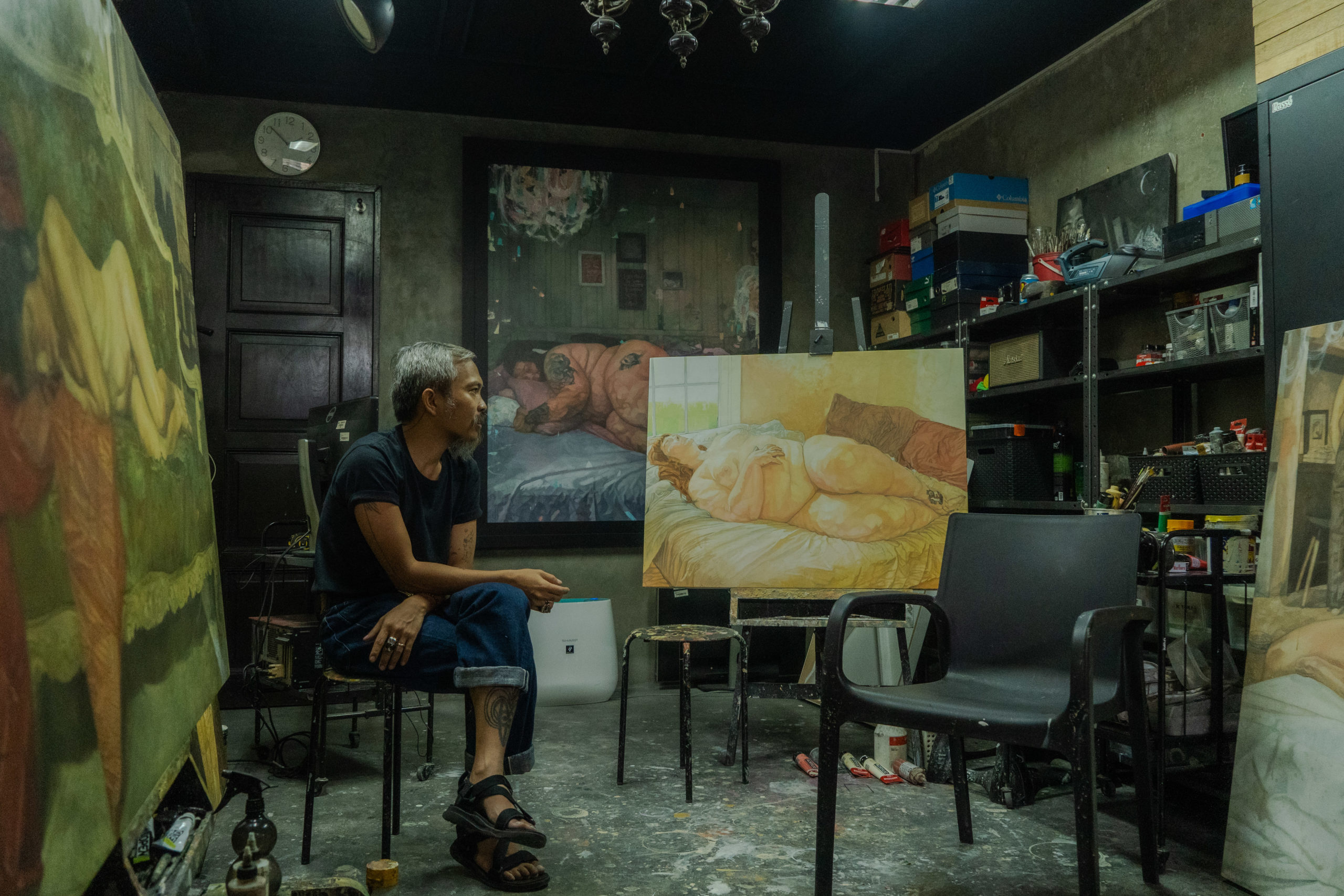In a city known for its floods, Malabon’s sunny weather came as a surprise. The Lifestyle.INQ Team was in Malabon for an interview with an artist known to evade the public eye.
There’s a quality of folklore and magic in the far-off town. Malabon feels more like a province than an urbanized center. Freshly-painted Sto Niños and Virgin Mary reliquaries stand in niches built into crumbling walls. The buildings have a look of decay. From most streets you can glimpse the bayside of the Tullahan River or interconnected esteros. The water mingles with the scent of Rufina patis. A flood-line snakes along the wall. In previous years, before the local government built flood gates, the mossy mark was a sign that it was never too long before water filled the streets. We’re walking through one of the oldest municipalities, originally part of Rizal province.
Standing outside Jamicos, Malabon’s classic crispy pata joint, three people passing on trikes stop to chat with the artist. He banters for a few minutes and gives out quick instructions. “Batas yata si Kaloy, ” our photographer jokes.
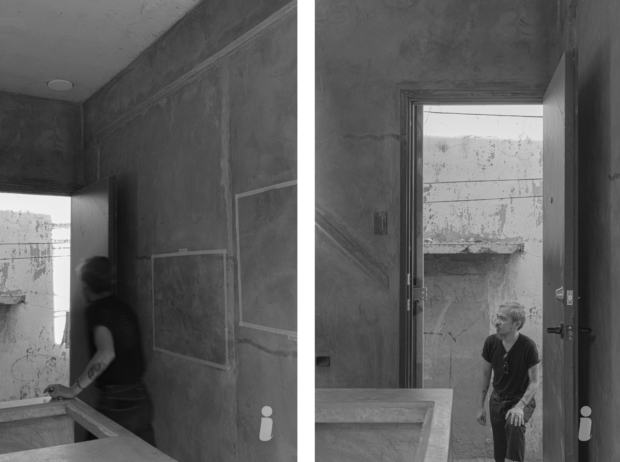
This is the city where Kaloy Sanchez was born and raised. He cites Malabon as the home of his clan and the place of his roots. He mentions his grandfather was a painter too, though penniless. This led his father to oppose a career as an artist. Although he repeated how his mother was endlessly supportive. Despite this, his journey was not without challenges. Reminiscing about his college days, he tells us how during one rain-heavy thunderstorm, he had to hitch on the back of a garbage truck to get to his exam in the University of the Philippines Diliman. The emerging artist came from a generation when there was no money in art too. Being a young painter in the early 2000s, the art scene was not as thriving as it is today. He would take animation jobs to buy painting materials. As he continued to create, he found art had a therapeutic effect dealing with a difficult childhood. So in his willfulness, he pursued. “When I found out I could create, I could escape, I was hooked. It was a gateway. It wasn’t for fame, or awards, or anything. Art was all I could do and all I wanted to do.”
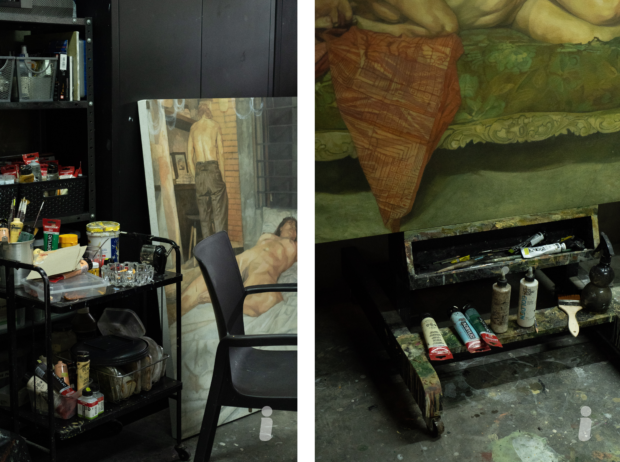
The Frustrated Architect
Comfortable with isolation, and known to be reclusive, we check in where Sanchez is now. He sits on a bar stool in the half-built area of his home, cold brew and Marlboro light in hand. After reflecting on what he could do during the pandemic, he expressed how he is at the point where he can do what he wants. “Life was too fast and with Covid it went slow. And then you’re just left with your senses.” Together, he and his wife Celine bought the empty lot behind the ancestral home Sanchez inherited from his mother. Then in January this year, they began to build this addition to their living space. In a day in the life, the artist works on personal errands and the construction of the house extension in the morning. He prefers to paint at night because the streets are quiet. In recent months, he has been simultaneously working on an upcoming show at MO_Space.
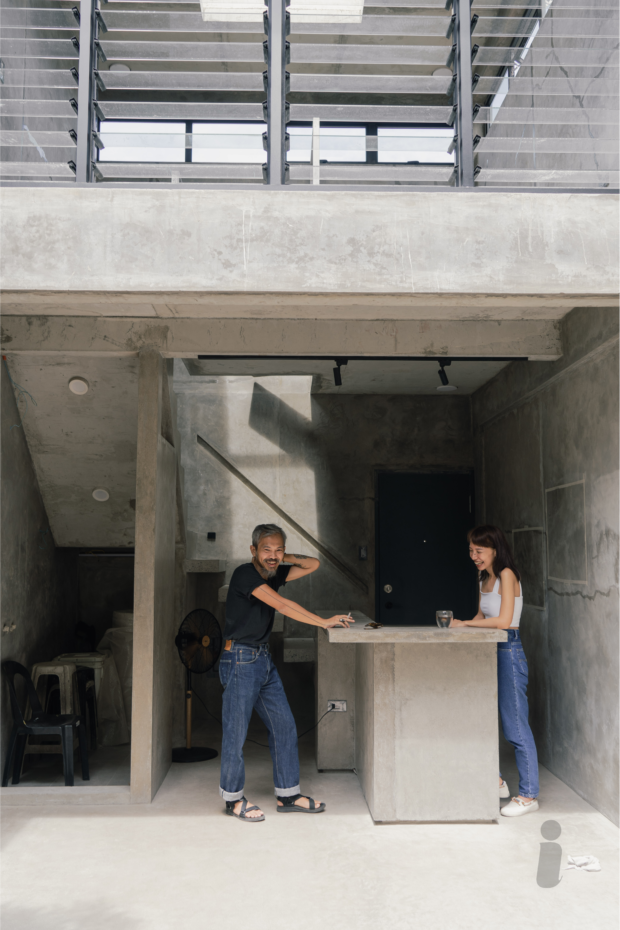
The artist is hands-on and meticulous with the building project. Despite being under construction, the space is well-kept with polished stone textures and solid geometry. The connecting section is laden with fire bricks, a building material Sanchez favored after three years living in Malaysia. A lanky Moringa tree towers at the center, which he and his wife praise for its medicinal properties. Smaller plants flow out of their pots in the neighboring alley and the overhead balcony.
Sanchez surprises us by expressing he was once on the verge of enrolling at the College of Architecture in the University of Santo Tomas. He shares that more than a daydream, he always wanted to build a house of his own. Looking at these designs, it’s no longer a daydream, but now a concrete-and-brick reality.
“If you look at my artworks and this,” he gestures to the sleek concrete, “It’s very different. It’s two different worlds. But that is probably the other side of me. The frustrated architect.”
Although there are differences between Sanchez’s art and ventures into architecture. He reflects that if there is a connection, “It would be the spaces. I’ve always been fascinated with spaces, with structure, with form.”
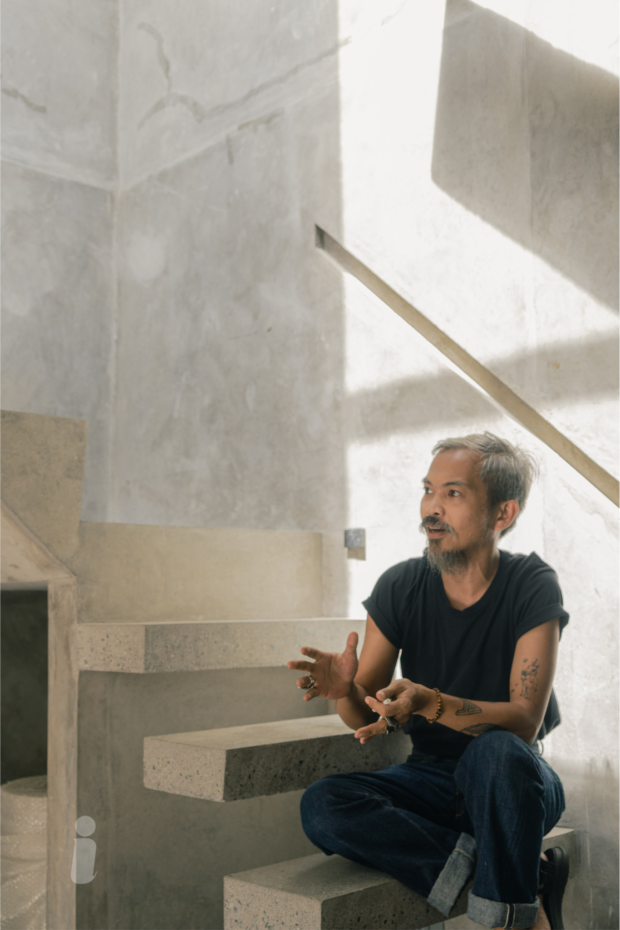
Honest portraits and the human condition
Kaloy Sanchez is now twenty years into a career that has been steady on the uptake. Familiar to the art world, he has held many shows in Manila and just as many abroad; from the long-established West Gallery in Quezon City to exhibitions in Berlin, Jakarta and Singapore with ARNDT art agency. He has also been a part of the discerning curatorial program of the Malaysian gallery of Valentine Willie. He works on the large-scale, often toiling over a single painting per month. The work is layered with philosophical labor and built solidly with detailed brushstrokes. While his style has changed in decades of art-making, the core of his practice remains the same: portraits of unconventional figures unraveling in their intimate space.
Standing in front of a painting by Kaloy Sanchez, the first question that comes to mind is – What is the story of the subject? Sanchez lets us in on his process: To take his references, the artist first visits the subject in their personal spaces. “My work is on humans in their spaces. I think people tend to shed their true selves in their spaces. We are freaks when left alone. Lumalabas lahat yan.”
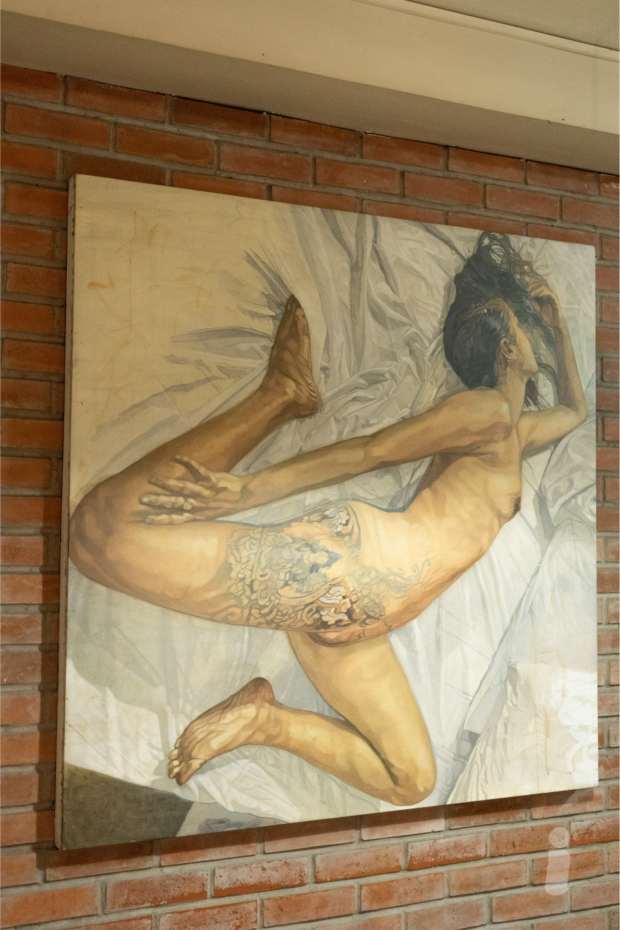
“The body sometimes gets rigid because there’s anxiety. When you translate it into painting or photos you would see if it’s forced. So in the photo sessions, I let them be.” He prefers the subjects to relax, preferably in their bedroom, where one is most comfortable and themselves. “Go naked,” he says, “Let’s talk, settle down. If you wanna drink, smoke. If I see them calm down, na nasa elemento na, that’s when I say don’t mind me taking pictures – I’ll just take shots. You just be. It’s very organic. I want honesty in my paintings, especially when trying to portray a person.” From these casual reference-taking sessions, Sanchez uses their stories from the fortright conversations. When it’s time to return to the studio, he includes their personal effects into the paint. The setting of the painting becomes a realm where you can dip into the subject’s own psychologies and beliefs. He argues it should not resemble real life. “If they say it looks alike,” he jokes, “then just take a photo.”
Sanchez adds another layer to his process of portraiture as he asserts “himself as an artist” must be included. “When you’re in your studio, any creative output is a self portrait. You instill a part of yourself. For example if I paint a portrait of Angela, it is what I see of Angela. It’s not Angela. So I am painting Angela but I’m also instilling my views.”
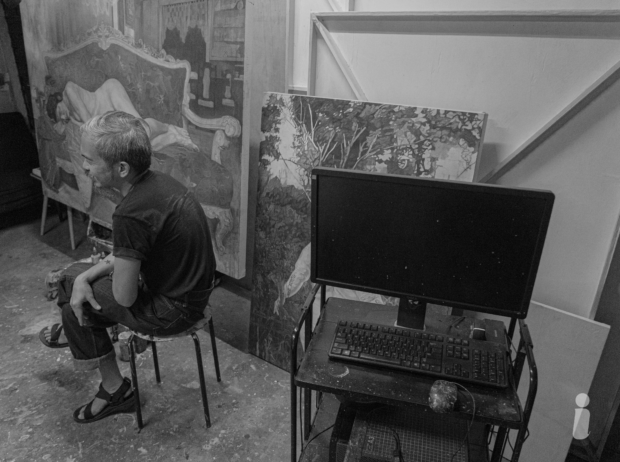
We look around at his own space. His studio is clean and organized. An unplugged desktop transforms with artfully splattered paint. The shelves are stacked with Charles Bukowski poems, a bio on Leonardo da Vinci, and a guide to Victorian painting. He pulls out a hulking copy of “No Chaos No Party”, a hard-back book of 28 major artists in Metro Manila. Its kaleidoscopic cover glints in a cheeky portrait of Romeo Lee. He pulls to a page showing his painting “Onan” from 2012. Kaloy is portrayed sitting in his old studio in Malaysia, pleasuring himself while throwing back a cup of coffee. An unseen person sits casually across him. In “Onan”, he asserts that masturbation should be as normalized as a cup of coffee, “Everyone masturbates and it’s something we don’t talk about. But it’s true. It’s a known secret everyone is doing it. Those are the stories that I talk about.” Some of us in the team (me) blush furiously.
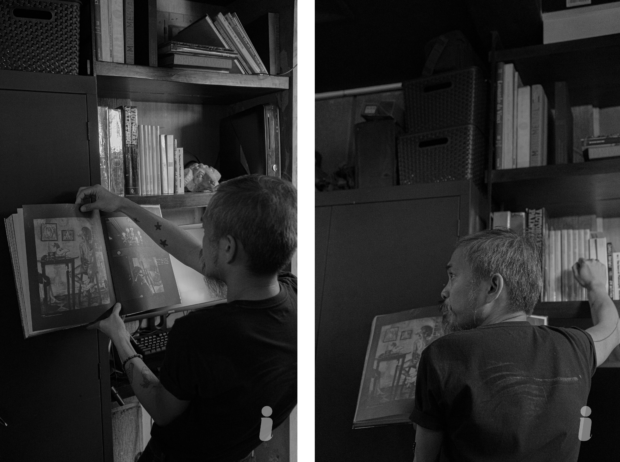
Yet Sanchez wants to cancel the erotic ideas imposed on his art. He calls it out as a misconception that errs on the danger of objectifying men and women. Whenever you look at his paintings, it’s never the slim nude with the graceful curves anyway. It’s a body that tells a story.
“That’s the beauty of painting. You’re a storyteller. You can’t just transfer a reference,” he says. “You add something.” He opts not to paint sitters that are already beautiful either. Instead he covers all body shapes, like his own naked figure, while zooming in on the skin’s real gritty bits. “I like flaws because we tend to look for beauty. I think it’s senseless, a waste of energy to paint something already beautiful. What can you achieve there?” His objective is unconventional. “That’s my goal,” he says, “to search for that beauty in ugliness. I like that oxymoron. You’re trying to find beauty from things that normally people would consider ugly, like aging probably. Flaws in the skin, stretch marks, I love all those things because we’re flesh and bones.”
When asked what personality traits are reflected in his paintings, he says “I am an introvert. I’m very comfortable in my own private space. A lot of my works tend to be philosophical thoughts about existence, mundane everyday things, mortality or death – all very human.”
As a visual storyteller, Sanchez’ running theme is on the human condition. His paintings of the subject’s personal details make the portrait more real. While he backs each work with art theory, he exercises his skill through a test of double-portraits. He also warns artists it can be tiring to share yourself through art-making, and reminds people who create to save something for themselves.
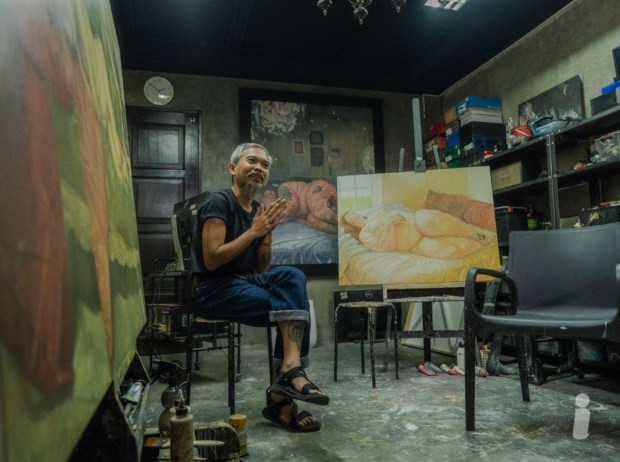
An evolving practice
While the process of Kaloy Sanchez is unchanged and his focus still revolves on the human condition, there have been changes to his body of work. His new paintings veer away from his past tendency to use thick, muggy textures in monochromatic tones.
Could it be because he got married last year? Sanchez laughs. He doesn’t answer and instead points to the studio space, “I think for a lot of the creative output of artists, the environment has something to do with it. May iba ka nang studio, mag-iiba trabaho mo. You try to cope with the people and it transfers to you. The process changes depending on the situation around you.” While he credits this unconscious shift to internal and external environments, we admire the glow and see the real change in his latest paintings soon to be exhibited.
These new works radiate a sense of lightness. One image shows sunlight streaming onto a large nude redhead. She splays confidently across an open window. In a painted red brick space, passions are tangible as a bare-all moment occurs between a faceless couple. Perhaps most striking is a vignette of a transexual woman, sleeping soundly on an ornate sofa as she clutches a piece of fabric from her drag wardrobe. We ask Sanchez about his artistic choice to explore the concept of sleep. He answers, “Half of our life is spent sleeping. It’s a very mundane, very common practice, but also very complex.” As the figures come out of the bedsheet, we become witness to the intimacies and the strangeness of human form.
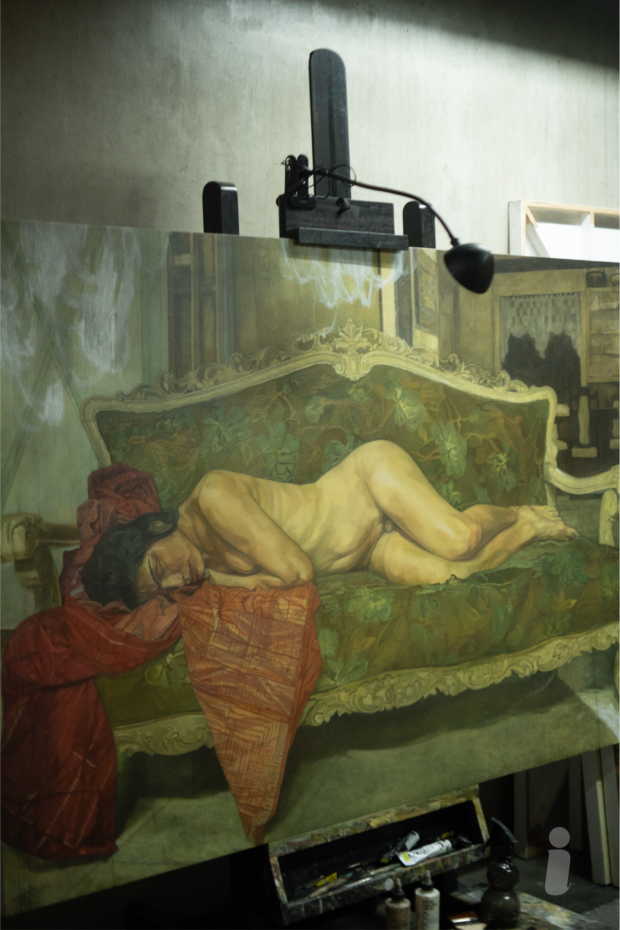
The growing art world
Aside from construction projects, new shows and expanding his oeuvre, Sanchez discusses his latest involvement with PARA Collective. Still in its early stages, group of artists Valeria Chua, Martin Honasan, Jason Montinola, Krista Nogueras, Nix Puno, Dexter Sy, RA Tijing, Victoria,
Ciane Xavier and Kaloy Sanchez, have started a series of institutionalized shows focusing on community in the art world. In 2022 they have held three group exhibitions so far — “Prequel / Sequel” at West, “Open Realms” at Underground and “Man and Monster” at Orange Project in Bacolod City.
When asked about the larger art community as a Filipino who has exhibited abroad, Sanchez says it is no longer difficult for a Philippine artist to break the transnational barrier. Instead, he points out one of the difficulties is that foreign entities tend to regionalize you – if not Philippine art, as Southeast Asian art. The same goes for artists of other nationalities. The challenge is how long you can show abroad and have “that longevity, the support of people outside your country.” He pauses, and adds about his own work, that “the human condition is a global issue enough.”
Career goals and organic landscapes
When asked if there is anything he would like to check off his proverbial bucket list, he pauses then answers, “It might sound cliche but masaya na ako. I can paint and support my painting so I think I can speak for myself.”
“I am not aiming for awards or fame. If I had a goal, it’s that you could be relevant when you get older. I think you have to take care of your career.” Instead of a bucket list, he marks an ambition, “The goal would be when I’m sixty, I can still paint and be relevant. People still come and see my works. I think that’s the end goal.”
Kaloy Sanchez is self-assured, intelligent, and calm, all the while appearing to be on top of everything. He welcomes guests into the No Man’s Land of Malabon with laughter and flow. Both the work and the person of Kaloy Sanchez appear to match the surrounding city. Like how a person ages more gracefully the less they try to change their face, both the physical and painterly landscapes are marked by a sense of honesty. They give way to decay and the natural cycles of life.
While looking at the walls outside his studio, the artist smiles and strikes a comparison, “You know,” he says, “it’s like how rust is so beautiful on metal,” as he rounds back to how everything in his art, city, and life is an organic process.
Kaloy Sanchez will be exhibiting these new paintings in his first solo exhibition in three years in “Kumot Yamot” at MO_Space, Taguig, 3rd floor, MOs Design B2 9th Avenue, Bonifacio High Street Taguig. Follow him on Instagram at @kaloysanchez.
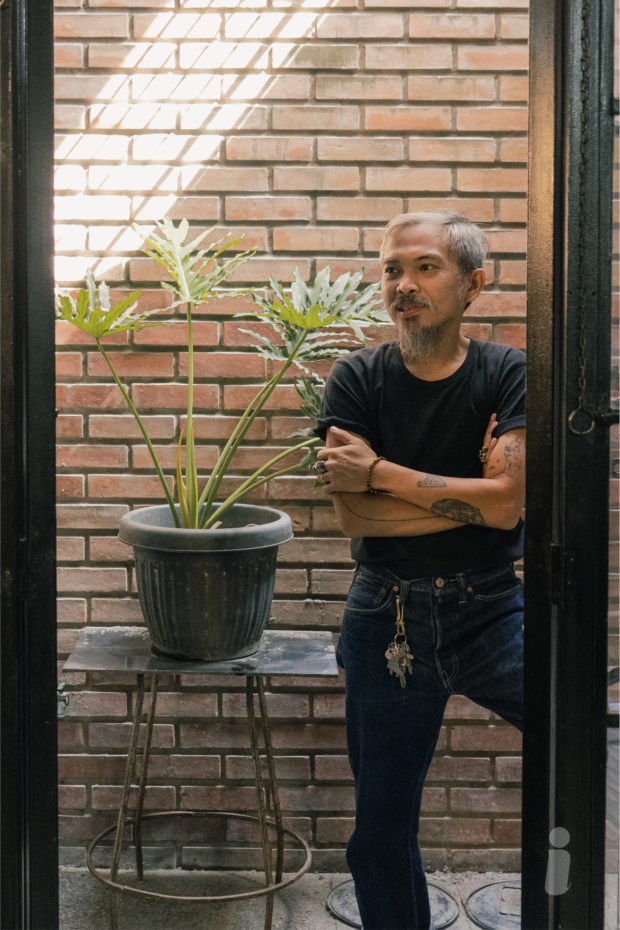
Photography by JT Fernandez
Creative Direction by Sophia Ysabel Concordia
Produced by Angela Manuel Go

